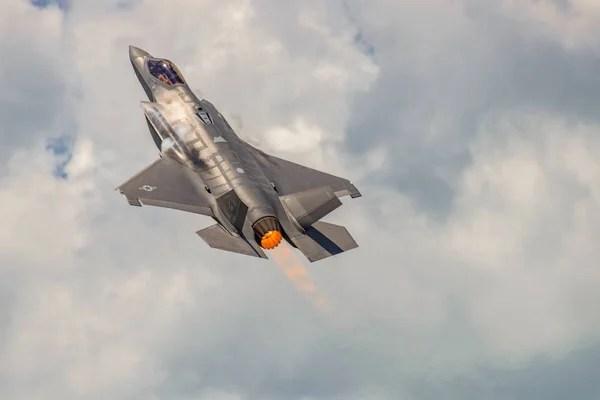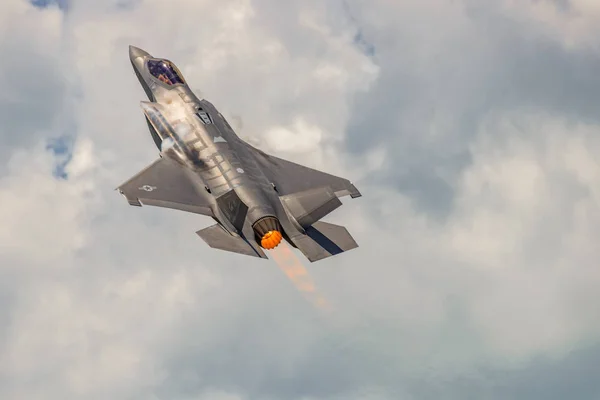“The legend of the unstoppable stealth fighter is now facing intense scrutiny in the context of war.” These are the statements, reported by The Economic Times, that are circulating within global defense circles, as Iran asserts it has brought down multiple Israeli F-35I Adir aircraft in actual combat.
Even though the accuracy of these claims remains unconfirmed, Israeli officials and external analysts have dismissed the circulating images as artificial intelligence-created forgeries. The mere idea of this situation marks a significant turning point in the ongoing struggle between stealth and detection.

For almost four decades, the F-35 Lightning II, considered Lockheed Martin’s most prestigious fifth-generation fighter, has symbolized Western air dominance. According to The Economic Times, its radar cross-section is “about the size of a golf ball,” measuring just 0.0015 square meters. This is achieved through three key engineering advancements: angular airframe design, cutting-edge radar-absorbent materials (RAM), and seamless integration of sensors and weapons inside the body. These features minimize radar reflections in X- and S-bands, making the F-35 nearly undetectable by older systems.
However, as demonstrated by recent military actions in Iran, stealth technology is not an entirely effective disguise. The emergence of new VHF (Very High Frequency) radar systems, such as China’s JY-27V and Russia’s Nebo-M, is significantly challenging the effectiveness of stealth capabilities. These systems operate at wavelengths between 1–10 meters, which are similar to key aircraft dimensions, allowing resonance effects to increase radar signals, thus reducing the effectiveness of traditional stealth design and radar-absorbent materials. According to a technical analysis from FlyAJetFighter, the Nebo-M’s RLM-M VHF array can detect targets with radar cross-sections smaller than 0.01 m² over distances exceeding 300 kilometers, while China’s JY-27A and JY-27V claim comparable or superior performance, utilizing AESA technology and AI-driven algorithms for rapid, adaptive detection.
These VHF radars do not serve as precise engagement systems; rather, they function as early warning components within a multi-layered sensor system. Their broad detection capabilities direct higher-frequency S- or X-band radars, which then guide missiles with high accuracy. This layered approach, now seen in Iranian strategies, has led to a reevaluation of how stealth aircraft are utilized and supported.
Iran is enhancing its air defense system in terms of scale and intricacy. The recently disclosed Bavar 373-II system, as reported by Army Recognition, features individual launcher units equipped with their own radar, enabling independent detection and targeting. The Sayyad 4B missiles within the system extend the engagement range to 300 kilometers, while the upgraded radar can track 60 targets at once and engage six simultaneously, offering performance that matches or exceeds many Russian and Western systems. Counterbalancing the Bavar 373-II are the S-300PMU2, provided by Russia, the Khordad 15, and a collection of domestic systems, all integrated into a decentralized, sensor-linked network designed to withstand attacks through electronic or physical means.
This complex framework is not just a result of technological advancements. It signifies a shift in doctrine towards decentralized, resilient defense systems that are less vulnerable to interference or disruption. According to the Washington Institute, Iran’s approach now includes deploying mobile units with independent targeting capabilities and the potential for regional spread, raising worries about anti-access/area-denial (A2AD) zones across the Gulf and further afield.
F-35 pilots encounter fresh operational and doctrinal challenges due to these developments. In areas with high VHF activity, they must perform meticulous route planning, avoiding known detection zones and utilizing terrain to remain hidden. Although the F-35’s AN/ASQ-239 electronic warfare system is advanced, it has limitations when facing the strength and wide beams of VHF radars, which are inherently more resistant to jamming. Survival now relies on cooperation: exchanging real-time data via Link 16 and MADL, working with ISR drones and electronic warfare planes, and using dynamic sensor integration to quickly adapt to emerging threats.
The F-35I “Adir” version of the Israeli Air Force, featuring a specialized electronic warfare system from Elbit Systems and localized weapon integration, showcases this flexible strategy. During “Operation Rising Lion,” the IAF reportedly used the F-35I’s intelligence and penetration capabilities alongside F-15I strike loads and drone assistance, conducting deep attacks on well-protected Iranian targets. According to Defense.info, the F-35I’s mission-ready rate of 85% significantly exceeds U.S. averages, highlighting the benefits of customized integration and strong support systems.
Nevertheless, the most sophisticated stealth technologies are not immune to the relationship between radar science and electronic warfare. The downing of the F-117A Nighthawk over Yugoslavia in 1999 serves as a reminder. As mentioned in The Diplomat and The Economic Times, Yugoslav forces exploited brief radar signals and predictable flight paths to activate X-band engagement radars by modifying VHF acquisition radars, resulting in a successful missile attack. The takeaway, emphasized by recent conflicts, is that stealth needs to be combined with electronic warfare, unpredictable strategies, and coordinated operations to remain effective.
Further examination is conducted on the technical principles of radar cross-section (RCS) and stealth design. According to Radartutorial, RCS is influenced by shape, frequency, and surface properties; stealth shaping and RAM are designed to minimize detection by shortwave radars but become less effective when radar wavelengths match the dimensions of aircraft components, leading to resonance and increased reflectivity. VHF radars exploit this vulnerability to detect stealth platforms at operationally significant distances.
The fast-growing nature of electronic warfare adds further complexity. According to Number Analytics, cognitive EW systems now use AI to make real-time adjustments, while distributed swarms of drones and networked jamming create electromagnetic pathways for attack groups. The F-35, featuring sensor fusion and a network-centric approach, is both an advantage and a participant in this shift, yet also faces challenges from enemies developing quantum radar and advanced countermeasures.
Sensor fusion and information dominance are rapidly emerging as the new frontlines. As stated by Trenton Systems, artificial intelligence-driven sensor fusion, high-speed secure networks, and precise timing are now essential for achieving operational advantage. Correlating real-time multi-domain sensor data, coordinating attacks, and distributing actionable intelligence swiftly are just as crucial as the physical attributes of stealth.
The events in Iran, regardless of the ultimate truth behind the shoot-down claims, suggest a world where the concept of invisibility is no longer certain. Influence is shifting away from traditional survivability based on platforms and towards the ongoing interaction of detection, deception, and networked defense. In this new landscape, invisible conflicts within the electromagnetic spectrum are increasingly determining the results of even the most advanced aircraft.







